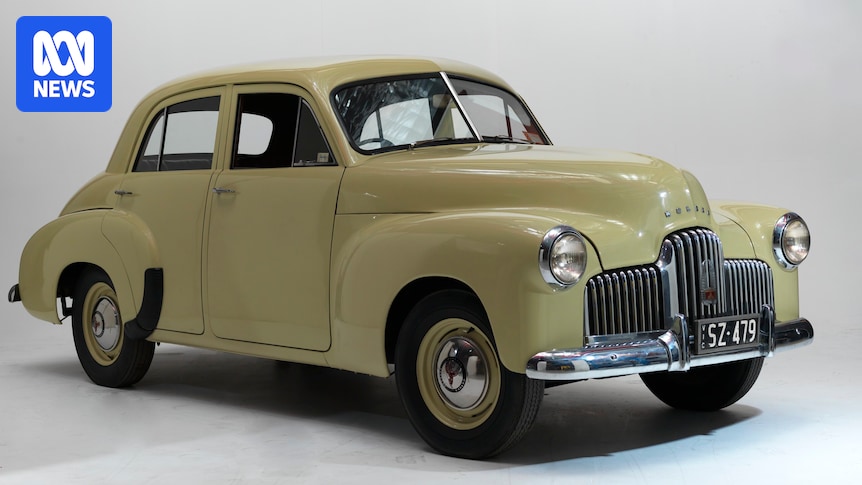Personalise the news and
stay in the know
Emergency
Backstory
Newsletters
中文新闻
BERITA BAHASA INDONESIA
TOK PISIN
By Tim Callanan
Today in History
Topic:Automotive Industry
One of the surviving Holden 48-215s. (Supplied: Museums Victoria)
Like most cars produced in the 1940s the Holden 48-215 was a rust bucket —but it was our rust bucket.
The car famous for being the first Australian-made automobile first rolled off the production line on November 29, 1948, at Holden's plant at Fishermans Bend in Melbourne.
It was a giant leap forward for the local car industry.
So much so that then-prime minister Ben Chifley was there for the grand unveiling of the first car made with local know-how.
Australia's then-prime minister Ben Chifley inspects the first Holden 48-215 to roll off the production line. (Supplied: National Library of Australia)
The 48-215 was not exactly a name to ignite the imagination of prospective buyers so it was initially just called the Holden, which is still a lot better then "the Canbra" which had been considered at one point.
Many years later it was dubbed the Holden FX.
Holden took out full page advertisements to promote its new Australian-made car. (Supplied: National Library of Australia)
The 48-215 went on to become the most popular car of the next decade in Australia, helping Holden reach annual sales of more than 30,000 vehicles by 1952.
In the 1930s and 40s there were popular American cars available in Australia from Ford, Chevrolet, Oldsmobile, Pontiac and Buick, but the Holden had a crucial point of difference, according to automotive historian and author Norm Darwin.
"They were expensive cars, and here we had a Holden that was right in the pocket of the average person," he said.
"The only cars that it was competing with were small, English four cylinder cars.
"It was very well priced and it was actually exactly what the market wanted at the time.
It was the brainchild of a man who was not even there to see it leave the factory for the first time.
The Second World War had not even reached the final stretch when the powers that be at General Motors Holden started thinking of and planning for the future.
That future, as far as they were concerned, involved Australian-made cars and lots of them.
Until that point in history, Australian-made cars were not a thing. There were certainly motor vehicles that were assembled here, but nothing in the way of locally designed and built vehicles.
That was to change thanks in part to the vision of Laurence Hartnett, the managing director of General Motors Holden (GMH) during a pivotal time in the car maker's history and a man often referred to as "The Father of Holden".
Holden was very keen to promote the 48-215 as an Australian-made product. (Supplied: State Library of South Australia)
During WWII, GMH was heavily involved in the production of army vehicles, anti-aircraft and anti-tank guns, boats, aircraft parts, ammunition boxes and a variety of other munitions.
According to a GMH wartime pamphlet, by 1945 the company devoted up to 90 per cent of its activity to wartime production.
Hartnett was happy to facilitate this as he capitalised on the opportunity to forge strong links between the company he ran and the government.
As the war was drawing to a close, GMH was perfectly placed to lobby the government for support in producing the first Australian made car.
The first Australian-made car rolled off the production line at Holden's plant at Fishermans Bend in Melbourne. (Supplied: State Library of Victoria)
British-born Hartnett had worked around the world before arriving in Australia in 1934 to head up GMH.
One of his first early, influential moves was to secure land at Fisherman's Bend in Melbourne to house a new manufacturing plant, enticing then-prime minister Joseph Lyons to open it.
Hartnett was desperate to develop an Australian car and even had prototypes built without the express permission of the company's head office in the United States.
He quietly lobbied Australian politicians to support the plan, which he was determined to put into action as soon as the war ended.
Hartnett (right), pictured here with then-prime minister Sir Robert Menzies, knew how to curry favour. (Supplied: State Library of NSW)
It was Hartnett's work on secretive prototypes that spurred his American superiors to intervene.
"That's when the Americans got involved and said 'look we're not sure we want you to do it all by yourself, you'd better bring it over here and we'll supervise it'," Dr Darwin said.
That was the beginning of a souring of the relationship between Hartnett and General Motors management as they clashed over very different visions for the first Australian-made car.
Clay models of the 48-215 were produced as Holden refined the design for its locally made car. (Supplied: General Motors Holden)
Eventually, Hartnett was given an ultimatum — move to the United States and take up a different role with General Motors, or leave the company.
He chose the latter.
That meant Hartnett, who remained in Australia after he left GMH, watched from afar as his brainchild rolled off the production line on November 29, 1948 — albeit in a very different form to what he had envisioned.
"It would have been a huge blow to his ego, there's no doubt about that," Dr Darwin said.
Hartnett's unrealised vision for the first locally-made Holden was something akin to the British Vauxhalls that were common in Australia in the 1930s and 1940s and, ironically, assembled here by GMH.
Not surprisingly, the General Motors vision was for something that more closely resembled the bigger and bolder US models produced by the likes of Ford, and GM's own brands Chevrolet and Buick.
Holden was proud of the design features of its first Australian-made car. (Supplied: State Library of South Australia)
Dr Darwin said the DNA of the first locally-made Holden was much more American than European.
"It was styled in America so it had an American feel about it, and most Australians were very comfortable with the big American cars," he said.
"It was the first modern, post-war car in Australia. The English cars that arrived here between 1946 and 1948 tended to be their pre-war models just simply reproduced and run out."
While his departure from GMH would have been a massive personal setback for Hartnett, he was still determined to produce his own Australian-made car.
Just three months after the first Holden made its debut, Hartnett unveiled his own Hartnett Motor Company with a goal of producing 10,000 vehicles a year.
Only a handful of Hartnett's own vehicle were produced, but one is held by Museums Victoria. (Supplied: Museums Victoria)
In the end, the first Hartnett vehicles were built with imported engines and components and sported a four-cylinder engine compared to Holden's six-cylinder.
There were only a handful of initial orders for Hartnett vehicles and only around 100 were ever made before the company folded in 1956.
Hartnett went on to pioneer the importation of Japanese cars into Australia.
But as far as Australian-made cars were concerned, Holden remained king of the road for decades.
Analysis by Jacob Greber
Topic:Corruption
Topic:Police
Topic:Fires
Analysis by Laura Tingle
Topic:Car Enthusiasm
Topic:Popular Culture
Topic:Community and Society
Automotive Industry
Docklands
History
Analysis by Jacob Greber
Topic:Corruption
Topic:Police
Topic:Fires
Analysis by Laura Tingle
Topic:Automotive Industry
Analysis by Jacob Greber
Analysis by Laura Tingle
Topic:Prisons
We acknowledge Aboriginal and Torres Strait Islander peoples as the First Australians and Traditional Custodians of the lands where we live, learn, and work.
This service may include material from Agence France-Presse (AFP), APTN, Reuters, AAP, CNN and the BBC World Service which is copyright and cannot be reproduced.
AEST = Australian Eastern Standard Time which is 10 hours ahead of GMT (Greenwich Mean Time)












